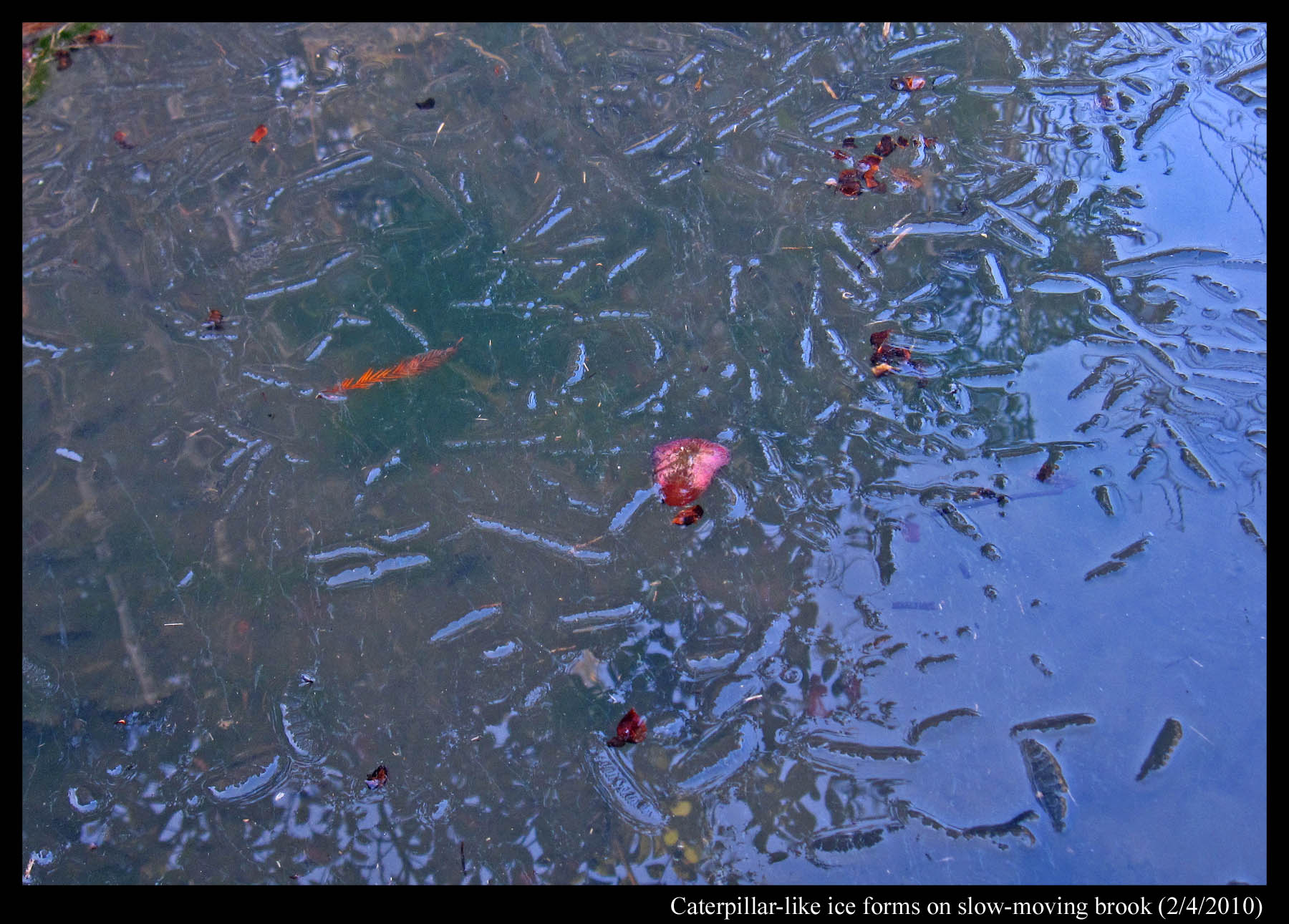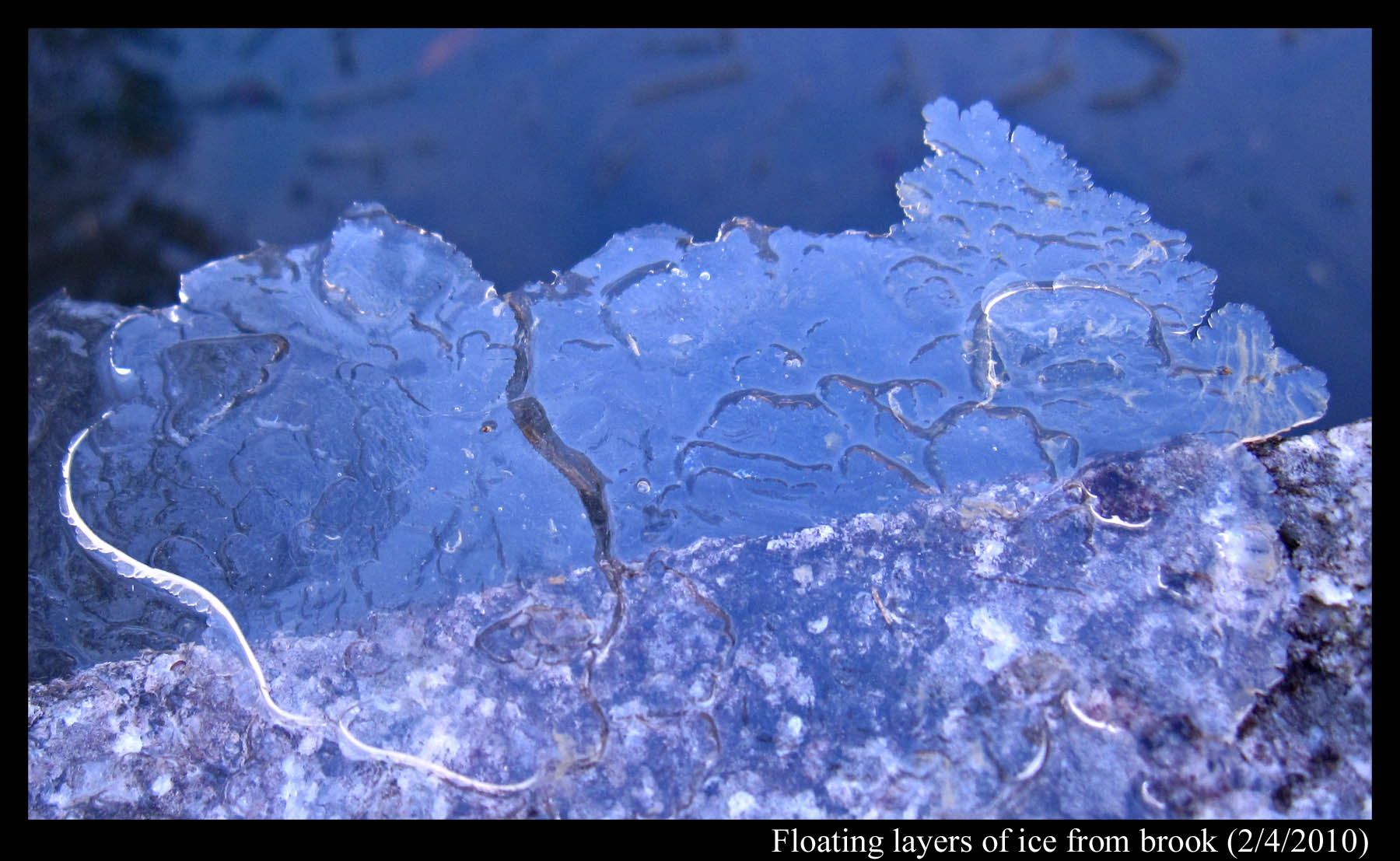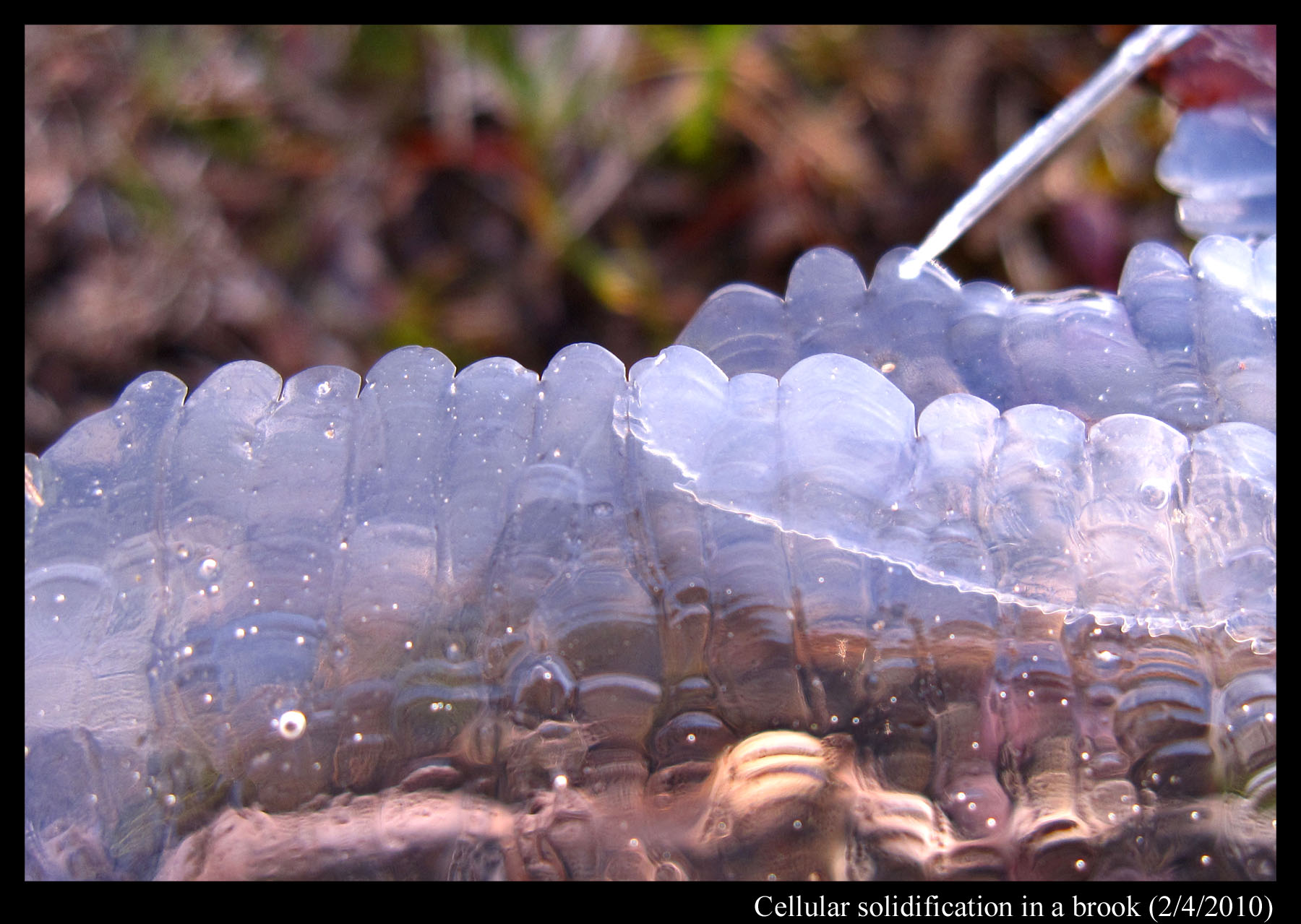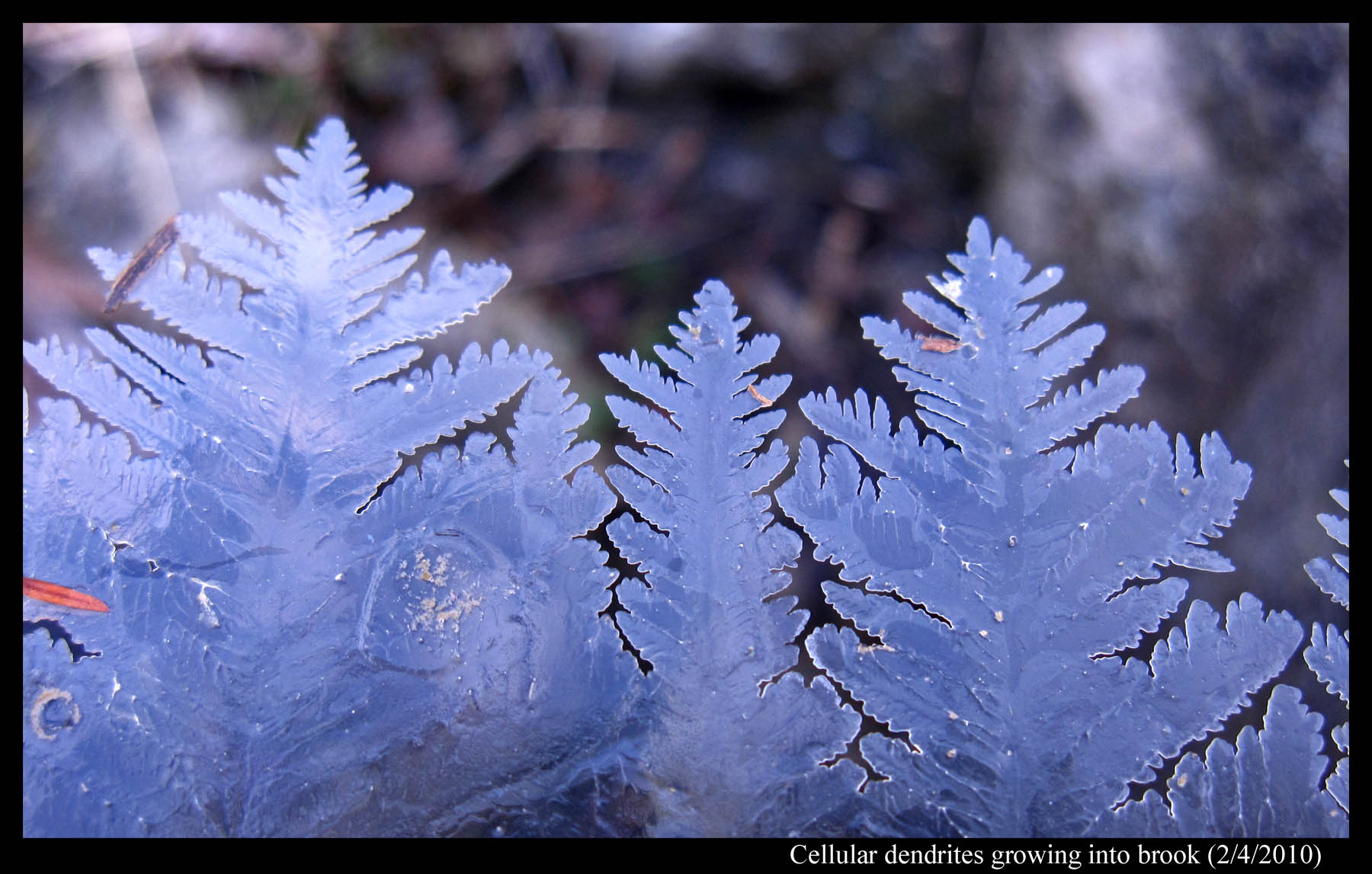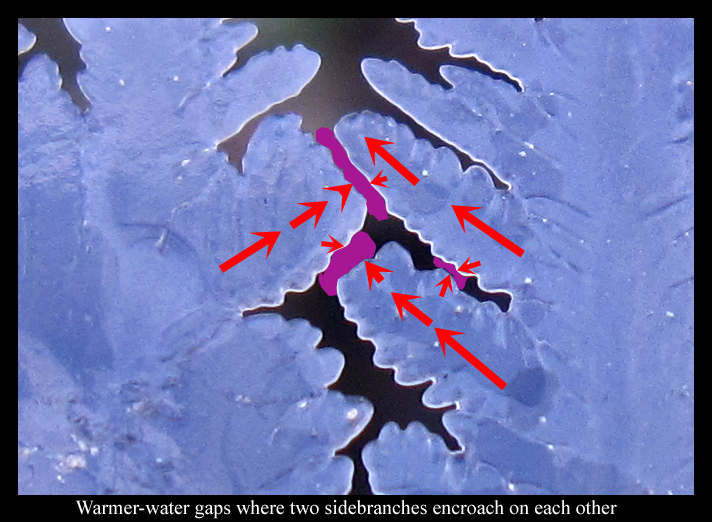| « Ice Forms on Slow-moving Water II: Pancakes and Frozen Foam | Hoared Hail and Coraline Cups » |
Ice Forms on Slow-moving Water I: Caterpillars and Cellular Dendrites
During my last winter in Japan (2009-2010), I would walk around a neighborhood park on frosty mornings, looking for interesting ice forms. It was in this park that I found one rock (only one!) that on some mornings would sprout hair-like ice, arising from liquid water within (see the last images in my “Ice on the Rocks” post, Jan 27). This park also has a small, slow-flowing brook that, despite the relatively warm conditions, often freezes over. Usually, upon freezing, it shows an ice pattern consisting of many long (~ one foot) straight lines – a typical pattern you usually see on glaciated puddles and ponds. But on the morning of February 4, at one spot right before the water tumbled over a waterfall, the ice surface looked slightly different. It had lines, but the lines were short, thick, and bumpy (see photo below), looking a bit like black-blue caterpillars scattered about.
From the small bridge spanning the brook, I reached down, pulled some ice out, and was shocked at what I saw. This was not “solid” ice, but rather a bunch of very thin ice plates loosely resting on each other – somewhat like a deck of cards spread out in a fan, though in this case, each ice plate had its own size and shape. Also, unlike other thin ice plates I’d seen before, these ones resembled neither the fast-growing ice dendrites (the snow-crystal-like, branched forms) nor the slow-growing ice discs. The photo below also shows that the plates were big – the section shown being several inches across.
Over larger streams and faster-moving water, ice can develop into something called frazil ice. I’ve no experience with frazil ice, never having lived in a cold-enough region, but I this caterpillar ice may be different. For one, the water was extremely slow-flowing. I could not discern the flow, even in ice-free regions, whereas the descriptions I’ve read about frazil ice involve easily discernable flow rates, flow rates that introduce turbulence, crystal collisions, and mixing below the surface. Also, the ice crystals I saw were much larger than the millimeter-sized pieces I see reported for frazil ice. So, the caterpillar form might be a transitional form, between frazil and that over stagnant water. But how could the ice have formed such layers, loosely stacked over each other? I suspect the flow played a role in getting the crystals stacked up, but why didn't they bond to each other? The observations of bank-anchored ice (below) suggest a possible answer.
I also noticed some curiously different bank-anchored ice. Nearby to the caterpillar forms, the ice that grew from the bank had a cellular growth pattern. Lots of descriptions of cellular growth exist in the scientific and engineering literature, though these are mainly studies of other materials. (See, for example, the article I listed below on the growth of succinonitrile.) For the picture below, I took the ice out of the brook and leaned it up against a small log, oriented to reflect the sky.
This directional type of growth, directional in that the cells all grew in the same direction, occurs where the source of water all lies in the same direction relative to the ice. In this case, the water was away from the bank. (In contrast, a star-shaped crystal grows out into water that surrounds it.) Moreover, this ice all lies in the same plane, which indicates that it is all one single crystal, and the simply rounded cusps indicate slow growth conditions. Where growth was faster, at a place along the bank further upstream, I found dendritic cellular growth.
Apparently, in this place the water was either colder or faster-flowing, causing the dendritic growth. But as I hypothesized for the non-dendritic case, this ice is all likely the same crystal. In further support of this idea, the directions of the sidebranches are all about 60 degrees to the primary growth direction, just like the branches on a snow crystal.
The image above shows three main branches growing into the water (though I removed the ice to take the picture), and notice that they have gaps between them. Why the gaps? If water exists all around the growing branches, why don’t they all merge? The answer gives us a clue about why the ice plates in the caterpillar forms didn’t merge into a solid mass of ice: the water trapped between the sidebranches, the black regions, is warmer than water elsewhere – probably within a hundredth of a degree of the melting temperature – warm enough that the ice can hardly grow. So the growth nearly stops and the ice takes a long time to merge. To see this better, I cropped out a small region near the center of the above image and blew it up below:
I added the red arrows to show the relative growth rate of different regions at different times (longer/faster at the beginning, shorter/slower later) and the purple to indicate warmer water. As water freezes, the water molecules crystallize and release heat. The heat, called the latent heat of fusion, spreads out from the source, diminishing as it spreads, though the growing regions of ice remain very close to the melting temperature. When the sidebranches first sprout, much water surrounds them, meaning the heat is quickly dissipated, causing them to grow quickly. Thus, the red growth arrows in the image start large. But as two sidebranches encroach further, the heat gets trapped, making the temperature of the water between them closer to melting and the growth slower. Hence, a gap of water tends to remain between two growing pieces of ice, and only slowly do they merge into one solid piece of ice. Perhaps this helps to explain the caterpillar ice.
- JN
See the article on cellular growth in the Proceedings of the National Academy of Sciences article, freely available at
http://www.pnas.org/content/95/2/431.full.pdf
